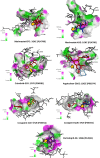Evaluation of tea (Camellia sinensis L.) phytochemicals as multi-disease modulators, a multidimensional in silico strategy with the combinations of network pharmacology, pharmacophore analysis, statistics and molecular docking
- PMID: 35536529
- PMCID: PMC9086669
- DOI: 10.1007/s11030-022-10437-1
Evaluation of tea (Camellia sinensis L.) phytochemicals as multi-disease modulators, a multidimensional in silico strategy with the combinations of network pharmacology, pharmacophore analysis, statistics and molecular docking
Abstract
Tea (Camellia sinensis L.) is considered as to be one of the most consumed beverages globally and a reservoir of phytochemicals with immense health benefits. Despite numerous advantages, tea compounds lack a robust multi-disease target study. In this work, we presented a unique in silico approach consisting of molecular docking, multivariate statistics, pharmacophore analysis, and network pharmacology approaches. Eight tea phytochemicals were identified through literature mining, namely gallic acid, catechin, epigallocatechin gallate, epicatechin, epicatechin gallate (ECG), quercetin, kaempferol, and ellagic acid, based on their richness in tea leaves. Further, exploration of databases revealed 30 target proteins related to the pharmacological properties of tea compounds and multiple associated diseases. Molecular docking experiment with eight tea compounds and all 30 proteins revealed that except gallic acid all other seven phytochemicals had potential inhibitory activities against these targets. The docking experiment was validated by comparing the binding affinities (Kcal mol-1) of the compounds with known drug molecules for the respective proteins. Further, with the aid of the application of statistical tools (principal component analysis and clustering), we identified two major clusters of phytochemicals based on their chemical properties and docking scores (Kcal mol-1). Pharmacophore analysis of these clusters revealed the functional descriptors of phytochemicals, related to the ligand-protein docking interactions. Tripartite network was constructed based on the docking scores, and it consisted of seven tea phytochemicals (gallic acid was excluded) targeting five proteins and ten associated diseases. Epicatechin gallate (ECG)-hepatocyte growth factor receptor (PDB id 1FYR) complex was found to be highest in docking performance (10 kcal mol-1). Finally, molecular dynamic simulation showed that ECG-1FYR could make a stable complex in the near-native physiological condition.
Keywords: Diseases; Molecular docking; Network pharmacology; Phytochemicals; Simulation; Statistics; Tea.
© 2022. The Author(s), under exclusive licence to Springer Nature Switzerland AG.
Conflict of interest statement
The authors have no relevant financial or non-financial interests to disclose.
Figures








Similar articles
-
Prostate Cancer and Tea: CYP17A1 Inhibition by Phytochemicals from Tea Plant Camellia sinensis L. and Implications for Anti-androgenic Effect.OMICS. 2025 Jun;29(6):246-258. doi: 10.1089/omi.2025.0013. Epub 2025 May 20. OMICS. 2025. PMID: 40391648
-
Extraction Kinetics of phytochemicals and antioxidant activity during black tea (Camellia sinensis L.) brewing.Nutr J. 2015 Jul 31;14:74. doi: 10.1186/s12937-015-0060-x. Nutr J. 2015. PMID: 26226943 Free PMC article.
-
Computational aided mechanistic understanding of Camellia sinensis bioactive compounds against co-chaperone p23 as potential anticancer agent.J Cell Biochem. 2019 Nov;120(11):19064-19075. doi: 10.1002/jcb.29229. Epub 2019 Jun 30. J Cell Biochem. 2019. PMID: 31257629
-
Chemistry and Pharmacology of Natural Catechins from Camellia sinensis as Anti-MRSA Agents.Curr Top Med Chem. 2021 Oct 25;21(17):1519-1537. doi: 10.2174/1568026621666210524100632. Curr Top Med Chem. 2021. PMID: 34030615 Review.
-
The synergistic potential of various teas, herbs and therapeutic drugs in health improvement: a review.J Sci Food Agric. 2017 Nov;97(14):4679-4689. doi: 10.1002/jsfa.8472. Epub 2017 Jul 27. J Sci Food Agric. 2017. PMID: 28585285 Review.
Cited by
-
Evaluation of therapeutic potentials of selected phytochemicals against Nipah virus, a multi-dimensional in silico study.3 Biotech. 2023 Jun;13(6):174. doi: 10.1007/s13205-023-03595-y. Epub 2023 May 10. 3 Biotech. 2023. PMID: 37180429 Free PMC article.
-
Synthesis and Isolation of Phenol- and Thiol-Derived Epicatechin Adducts Prepared from Avocado Peel Procyanidins Using Centrifugal Partition Chromatography and the Evaluation of Their Antimicrobial and Antioxidant Activity.Molecules. 2024 Jun 17;29(12):2872. doi: 10.3390/molecules29122872. Molecules. 2024. PMID: 38930937 Free PMC article.
-
Network pharmacology and molecular docking: combined computational approaches to explore the antihypertensive potential of Fabaceae species.Bioresour Bioprocess. 2024 May 20;11(1):53. doi: 10.1186/s40643-024-00764-6. Bioresour Bioprocess. 2024. PMID: 38767701 Free PMC article.
-
Antidiabetic Actions of Ethanol Extract of Camellia sinensis Leaf Ameliorates Insulin Secretion, Inhibits the DPP-IV Enzyme, Improves Glucose Tolerance, and Increases Active GLP-1 (7-36) Levels in High-Fat-Diet-Fed Rats.Medicines (Basel). 2022 Nov 11;9(11):56. doi: 10.3390/medicines9110056. Medicines (Basel). 2022. PMID: 36422117 Free PMC article.
-
Revealing the role of metformin in gastric intestinal metaplasia treatment.Front Pharmacol. 2024 Jul 19;15:1340309. doi: 10.3389/fphar.2024.1340309. eCollection 2024. Front Pharmacol. 2024. PMID: 39101145 Free PMC article.
References
-
- De B, Bhandari K, Katakam P, Goswami TK. Development of a standardized combined plant extract containing nutraceutical formulation ameliorating metabolic syndrome components. SN Appl Sci. 2019;1:1–12. doi: 10.1007/s42452-019-1518-9. - DOI
-
- Abu Bakar MF, Mohamed M, Rahmat A, Fry J. Phytochemicals and antioxidant activity of different parts of bambangan (Mangifera pajang) and tarap (Artocarpus odoratissimus) Food Chem. 2009;113:479–483. doi: 10.1016/j.foodchem.2008.07.081. - DOI
-
- Siddiqui M, Shah N, Dur-re-shahwar M, et al. The phytochemical analysis of some medicinal plants. J Liaquat Univ Med Health Sci. 2021 doi: 10.38106/LMRJ.2021.3.1-02. - DOI
MeSH terms
Substances
Grants and funding
LinkOut - more resources
Full Text Sources

